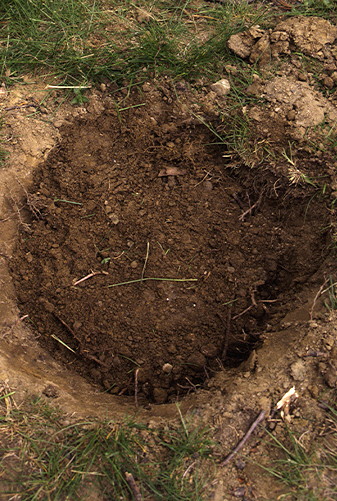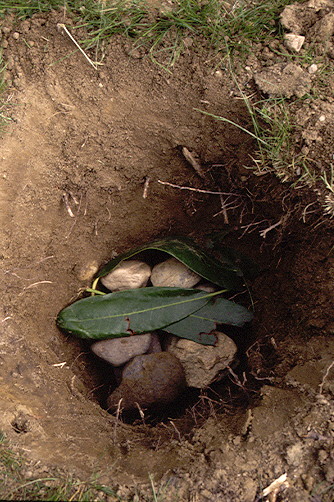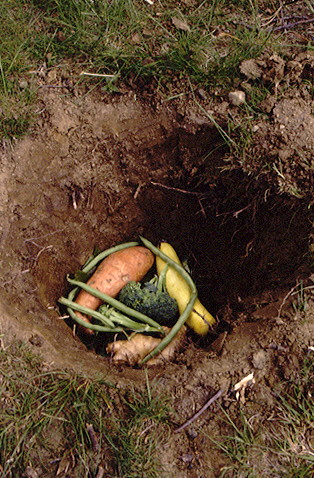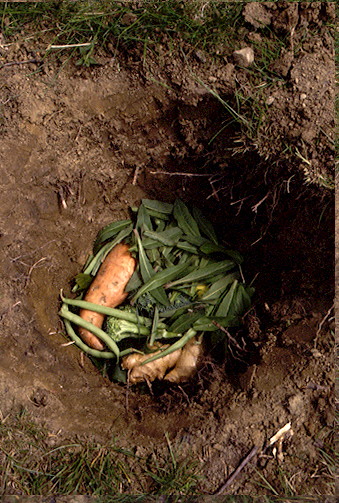
Earthen Oven (Mumu),
Papua New Guinea,
1700 CE
by Adrien Hansel, '98
 This is a recreation of a mumu, an earthen oven from the highlands of Papua New Guinea. The people of Papua New Guinea traditionally have no cooking pots: even in modern times, many of those who live in the bush have only one pot that they save for special occasions. Most food is roasted over a fire, which will do for a family but is an impractical way to cook for a larger party.
This is a recreation of a mumu, an earthen oven from the highlands of Papua New Guinea. The people of Papua New Guinea traditionally have no cooking pots: even in modern times, many of those who live in the bush have only one pot that they save for special occasions. Most food is roasted over a fire, which will do for a family but is an impractical way to cook for a larger party.
The mumu, on the other hand, is dug to fit the necessary specifications of available food and the number of people to be fed. In addition, it is an economical form of cooking in an area with diminished firewood resources. The oven cannot be constructed without the meal it is made to cook, and the term "mumu" encompasses both the oven and its layered feast, which is almost always a ceremonial feast of a ritually-slaughtered pig. Indeed, the development of the mumu has been traced to roughly three hundred years ago, when pigs large enough to be cooked became common in the country.
 After the hole was dug, stones were heated in it by
burning wood on top of them. Once the fire had burned down, all
but a thin layer of the hot stones were carefully removed, and a
layer of large leaves was laid on the base layer of stones to
steam the food.
After the hole was dug, stones were heated in it by
burning wood on top of them. Once the fire had burned down, all
but a thin layer of the hot stones were carefully removed, and a
layer of large leaves was laid on the base layer of stones to
steam the food.
Then followed a layer of hard vegetables,
including yams, corn, pumpkin and other traditional New Guinean
vegetables. Over this was a layer of smaller, edible and aromatic
leaves such as nasturtium.
 Then came another layer of hot stones,
directly under a specially-prepared pig. For a mumu, the pig was
cut open, leaving the limbs intact and the backbone whole, the
head was split in half to facilitate cooking, and the intestines
were removed and cooked separately. Another layer of leaves
covered the pig, and then the whole thing was covered completely
with earth.
Then came another layer of hot stones,
directly under a specially-prepared pig. For a mumu, the pig was
cut open, leaving the limbs intact and the backbone whole, the
head was split in half to facilitate cooking, and the intestines
were removed and cooked separately. Another layer of leaves
covered the pig, and then the whole thing was covered completely
with earth.
The pit would be left for several hours before the
contents were dug up and eaten. The feast was most often a form of
celebratory payment: either a bridal payment or a compensation
payment as
reparation for a death in a tribal fight.

 This is a recreation of a mumu, an earthen oven from the highlands of Papua New Guinea. The people of Papua New Guinea traditionally have no cooking pots: even in modern times, many of those who live in the bush have only one pot that they save for special occasions. Most food is roasted over a fire, which will do for a family but is an impractical way to cook for a larger party.
This is a recreation of a mumu, an earthen oven from the highlands of Papua New Guinea. The people of Papua New Guinea traditionally have no cooking pots: even in modern times, many of those who live in the bush have only one pot that they save for special occasions. Most food is roasted over a fire, which will do for a family but is an impractical way to cook for a larger party. After the hole was dug, stones were heated in it by
burning wood on top of them. Once the fire had burned down, all
but a thin layer of the hot stones were carefully removed, and a
layer of large leaves was laid on the base layer of stones to
steam the food.
After the hole was dug, stones were heated in it by
burning wood on top of them. Once the fire had burned down, all
but a thin layer of the hot stones were carefully removed, and a
layer of large leaves was laid on the base layer of stones to
steam the food.
 Then came another layer of hot stones,
directly under a specially-prepared pig. For a mumu, the pig was
cut open, leaving the limbs intact and the backbone whole, the
head was split in half to facilitate cooking, and the intestines
were removed and cooked separately. Another layer of leaves
covered the pig, and then the whole thing was covered completely
with earth.
Then came another layer of hot stones,
directly under a specially-prepared pig. For a mumu, the pig was
cut open, leaving the limbs intact and the backbone whole, the
head was split in half to facilitate cooking, and the intestines
were removed and cooked separately. Another layer of leaves
covered the pig, and then the whole thing was covered completely
with earth.